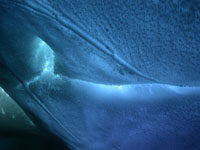|
|

|
|

|
Blue
light inside a fumarole on Mt. Erebus.
Click to enlarge.
|

|
|
|
|

|
|
Antarctic
Light
|

|
Sunlight
and ice combine to create natural art.
by Paul Doherty
December
13, 2001
The
light in Antarctica presents me with new colors and images
every day.
Observation
1: Noel and I descended into one of the ice towers made by
fumaroles on Mt. Erebus. Fumaroles are vents from which volcanic
gas escapes into the atmosphere. Ice towers are formed when
the hot gas condenses into ice deposits. Light filtering down
through the ice at the entrance was white. As we moved deeper
under the ice the light became deep blue because the water
molecules locked together in the ice absorbed the red from
the sunlight. Until, at the very deepest levels, the light
became a stunning violet.
Observation
2: The smoke plumes from Erebus were bluish in color. As the
plumes moved toward us their shadows on the snow were yellow
and yellowish-brown. Yellow and blue are complementary colors,
they add together to make white. When the clouds scatter the
blue light out of the white sunlight, only yellow light continues
on to strike the snow.
Observation
3: At Lower Erebus hut, the plume of Erebus passed between
me and the sun. The sun was immediately surrounded by three
reddish rings of corona about 12 degrees in total diameter.
The appearance of the circular coronal rings told me that
the cloud was made of supercooled water droplets, not ice
crystals. It was fun to see the sun as the bull;s eye in a
three-ring target.
|
|

|
|

|
A
Fata Morgana creates illusory cliffs at the base
of
Mt. Discovery.
|

|
|
|
|

|
Observation
4: Outside the window of our office in Crary Lab we look across
McMurdo Sound to Mount Discovery. One calm morning it looked
like someone had lifted up the entire mountain and that the
bottom had stretched upward like taffy. There seemed to be
a new set of cliffs ringing the bottom of the mountain. It
was a Fata Morgana, an inferior mirage—a mirage that
appears below an object—and light from the mountain bent
as it passed through different temperature layers of air above
the ice. Fata Morganas are named after Morgan le Fay, sister
to King Arthur, who was supposed to be able to change her
shape.
|

